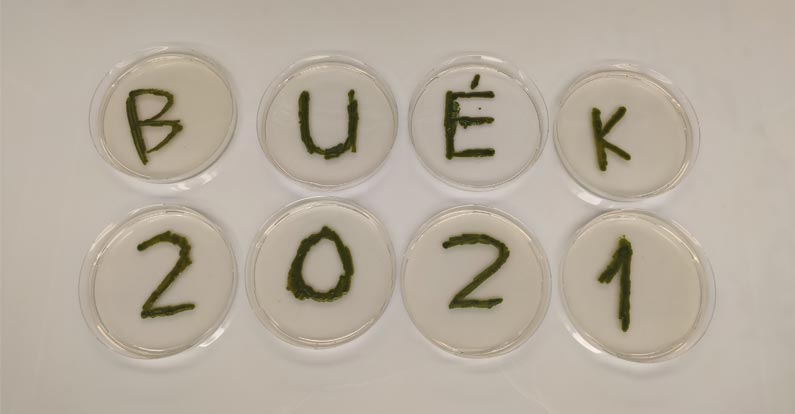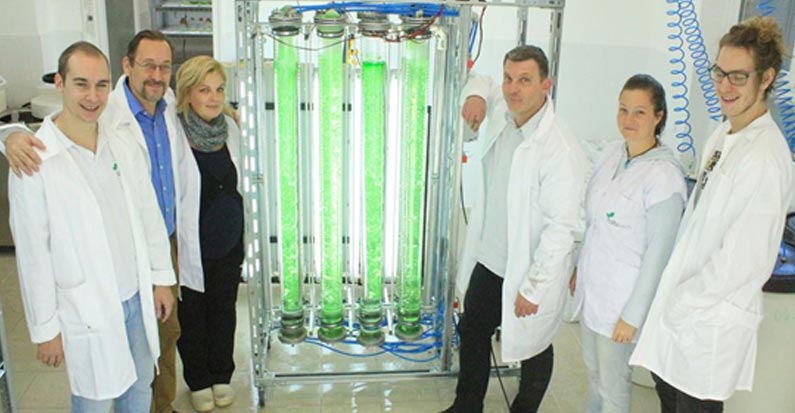Erika Greipel, Zsuzsanna Bencsik, Péter Futó, József Kutasi: Microalgaeas foliarfertilizer in agriculture
Abstract
Foliar fertilization is a widespread procedure in agriculture for applying inorganic fertilizers or other substances on the foliar surface of plants in order to enhance crop yield. The efficiency of foliar fertilization can be 8-20% better than solid fertilizers. Certain axenic, high-concentration algal cultures have a growth promoting effect on field cultivations, due to nitrogen-fixation and production of growth-promoting hormone-like substances. These concentrated suspension of microalgae and/or cyanobacteria – or its extract – efficiently enhance growth of plants by increasing plant height and leaf surface, improving germination capacity of seeds, or even increasing the clorophyll content of leaves, or the starch, oil and protein concentration of the fruit.
Our product, Algafix® is a liquid culture of microalgae, containing phytohormones, macro- and microelements. For home gardens, greenhouses, agricultural and horticultural use for mono- and dycotyledon cultivars. It contains Scenedesmus rubescens/obtusiusculus, a freshwater green microalga isolated from the Lake Balaton, Hungary. Between it’s plant hormone producing capacity it produses different lipids and molecules with antioxidant capacity which can delay the scenescence of leaves. About agricultural experiments it can be used for cereals, sunflower, corn, vegetables, fruit-trees, grape and also for indoor plants. According to the patent HU 1200251 Scenedesmus strains are cultivated together with the (plant growth promotion rhizobacteriae) Azospirillum brasilense NCAIM (P) 001411(National Collection of Agricultural and Industrial Microorganisms )reached surprisingly higher algae cell number and more effective plant stimulating properties. These bacteria are able to produce auxins, in the first line indole-3-acetic acid whitch can stimulate the proliferation and hormone production of algae. In this way cultivated microalga culture has 108cell/ml cell concentration, stimulate the germination, has antimicrobial and antifungal activity, furthermore in case of field plants stimulate the stem elongation and blossoming and increase the yield.
The cytokinine and gibberellin-like plant hormon production of axenic cultures of Scenedesmus sp. BEA(Banco Espanol de Algas) D01_12(Algafix®, Patent HU 1200251) Chlorella minutissima K 2012 (Albitech collection) and Botryococcus braunii green alga strains were investigated. In case of S. rubescens/obtusiusculus we found kinetin production an order of magnitude higher than in case of the other two strains. Trans-zeatin-riboside whitch is one of the most effective natural cytokinin was found in evapored extracts of B. braunii, C. minutissima and in S. obtusiusculus cultures as well. B. braunii cultures haven’t investigated in this field previously. It seems that the S. obtusiusculus, the strain of Algafix® foliar fertilizer is really suitable to use for regulating plants. These results can serve as a good basis for the development of algae-based foliar fertilizer products and for a better understanding of their mode of action.
Erika Greipel, Zsuzsanna Bencsik, Péter Futó, József Kutasi:
Preparated Cladophora cellulose, as a substrate of cellulase fermentation
Abstract
Some filamentous algae collected from the sea are used for paper production. Moreover, it can serve as a raw material of cellulose production as a more efficient substrate than plant cellulose. Moreover algae are currently exlioited by the food industry for a range of ingradients. The filamentous freshwater green algae Cladophora contents the cellwall cellulose mostly in the crystalline form. In contrast to the plant cell wall cellulose in this case the Iα whitch is more accessible to the enzymes is present in 63% while the Iβ form in 37%. Plants have reverse ratio making it difficult to process the fermentation plant cellulose. Cladophora cellulose forms gel structures at cellulose concentrations as low as 0.2% (w/v), whereas the lower threshold for the commercially available analog is around 1.5% (w/v) solids contents (Mihranyan 2011). It’s powder could be a useful alternative to commercially available dispersible cellulose grades when very low quantities of stabilizing agent are required.
With the extracted cellulose from Chladophora the cellulase enzyme induction in soil bacteria were investigated for facilitating and to enhance the production of enzymes. The bacterial digestion was performed on dried and milled, but untreated, Cladophora fibers as well. The success of the experiment can be explained by that the algae cell wall doesn’t contain lignin, which would inhibite the access of cellulase enzymes to the untreated material.




